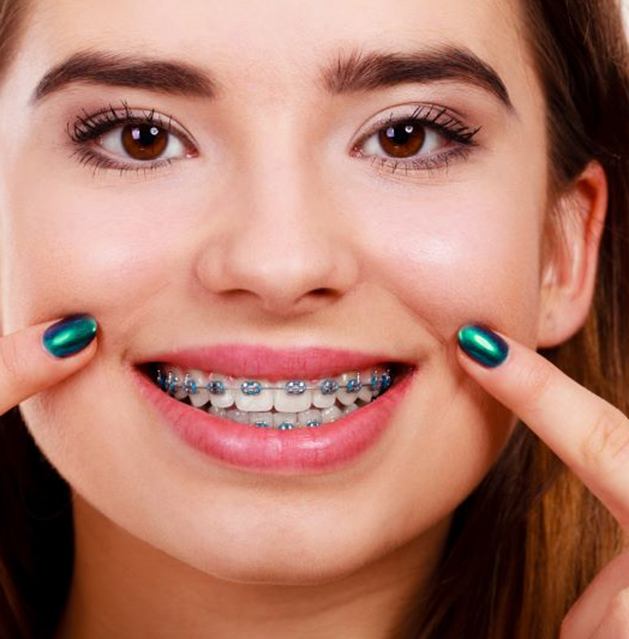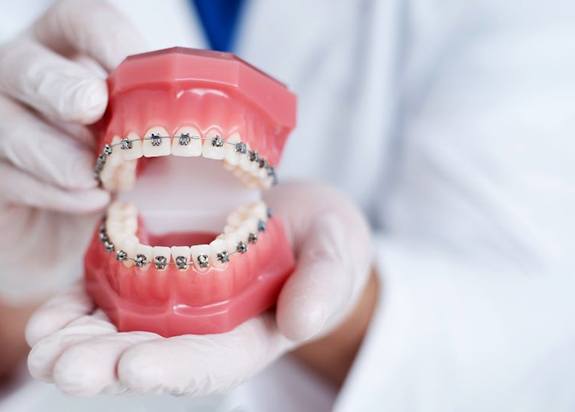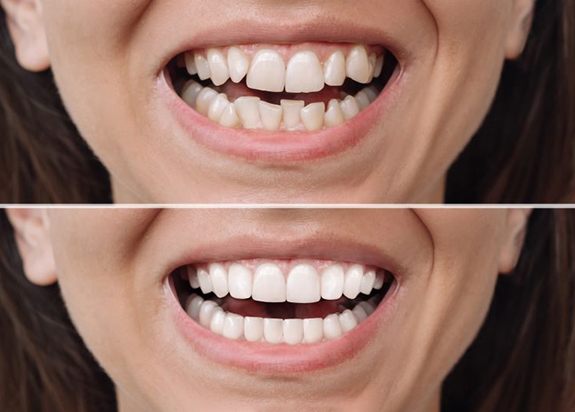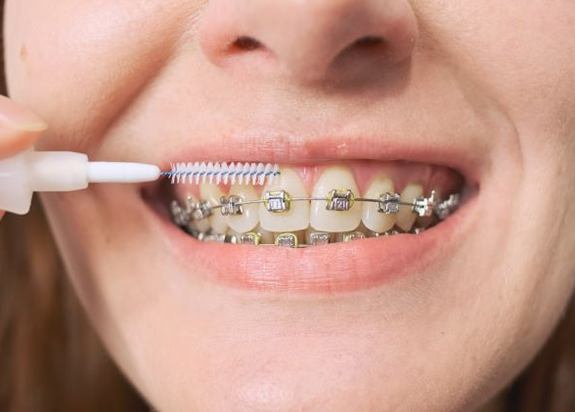Traditional Braces – Fresno, CA
A Straighter Smile Is Within Your Reach

Misaligned teeth can cause a number of daily inconveniences, and they put you at an increased risk of several oral health problems. Fortunately, traditional braces can put a straighter smile within your reach. Dr. Reintjes and our team are proud to offer this tried-and-true approach to orthodontic care right here in our Fresno dental office. Read this page to learn more about braces, and then give us a call when you are ready to book your consultation.
Why Choose Byron L. Reintjes, DDS, for Traditional Braces?
- Dentist with Decades of Experience
- Caring and Detail-Oriented Team
- Efficient & Predictable Tooth Movements
How Do Traditional Braces Work?

Traditional braces place gentle, sustained pressure on the teeth. Over time, they push teeth into their proper positions. They accomplish this through the use of a bracket and wire system. The average treatment time with braces can be anywhere from 12 to 36 months — it depends primarily on the extent of your dental misalignment. Throughout your treatment period, you will visit us every 6 – 8 weeks so we can keep your progress moving forward.
What Orthodontic Issues Can Braces Fix?

Braces are a versatile orthodontic treatment; they can correct most cases of dental misalignment and malocclusion (bad bite). During your consultation, we will assess the state of your teeth and jaws so we can determine if braces are a good fit for your unique circumstances.
Bite Misalignment
Overbite, underbite, open bite, and crossbite are all forms of malocclusion that can affect the way your upper and lower teeth work together. Braces, often along with specialized accessories, are usually able to correct such issues so you can avoid painful and expensive dental issues, such as TMJ disorder, down the road.
Crowded & Crooked Teeth
Crooked, crowded teeth can easily trap food between them, placing you at an increased risk of dental decay and gum disease. Braces can shift the teeth so each one has the space it needs to function optimally. Occasionally, one or more extractions are necessary to make room for braces.
Gapped Teeth
A large gap between the teeth can expose your gums and leave them vulnerable to injuries and other issues. Plus, many people dislike the aesthetics of a gap-toothed smile. Braces may be able to move your teeth closer together so you can enjoy improved oral health and heightened confidence.
Caring for Your Braces

Here are some tips to help you care for your braces and your teeth so you can avoid unnecessary delays throughout your treatment:
- Keep up with a regular routine of brushing and flossing. A floss threader or an Ortho-Pick can help you to floss around your braces.
- Avoid foods that might damage your braces. This includes very hard, sticky, and chewy foods.
- Attend all appointments as recommended. In addition to attending orthodontic appointments, you should also schedule regular cleanings and exams.
Traditional Braces FAQs
Do Traditional Braces Hurt?
This is perhaps one of the most asked questions about traditional braces. To be completely honest, some soreness is normal, especially in the days following your first appointment. The good news is that there are several ways you can alleviate any discomfort that arises, like using dental wax, sipping on cool water, and taking OTC pain medication. As you progress through your treatment plan, both the soft tissue in your mouth and your teeth will adjust, and – before you know it – you’ll have a perfectly straight smile.
Am I Too Old to Get Braces?
There’s a common misconception that the ship has sailed on having straight teeth if you’re no longer a teen. That’s not the case. In fact, adults make great patients because they are motivated to take good care of their smiles and follow the treatment guidelines provided! So, don’t let your age stop you from scheduling a consultation with us. We’d love to meet with you and review all of your orthodontic treatment options.
How Long Do Traditional Braces Take?
Typically, they take between one and three years. If you’re interested in getting an estimate of your treatment timeline, the best thing to do is schedule an appointment with us. That way, we can conduct a comprehensive oral exam, considering important factors, like the severity of your misalignment, along the way. At your visit, we will also discuss what to do to avoid falling off-track with your treatment plan, like prioritizing your adjustment appointments and sticking to the dietary restrictions.
Can I Get Traditional Braces on Just My Top or Bottom Teeth?
Straightening just one arch of teeth isn’t as common as you might think. After all, we need to consider both the position of your teeth and the alignment of your bite. In other words, if single-arch treatment would negatively impact the health and function of your bite, then it’s not an option.
With all of that said, there are some cases when getting braces on just the top or bottom teeth is possible. If you are interested in finding out if you’re a candidate, then don’t hesitate to schedule an appointment! Once we’ve assessed the severity of your case, we can determine if single-arch treatment will give you the healthy, beautiful smile you’re looking for.
What Happens After You Get Your Braces Off?
You might think your orthodontic treatment is over after we remove your braces. The reality is that there is another important step of the process: the retention phase. Basically, this involves keeping your teeth and bite in their perfectly aligned positions with a custom retainer. Sometimes, we ask patients to wear it around the clock for the first few months to make sure their teeth have “set” in place. After that, wearing it only at night should suffice.

